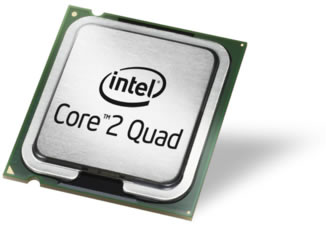In November 2006 Intel released the first in their range of Intel Core 2 Quad processors. Codenamed the ‘Kentsfield’, the newly released processors were two Core 2 Duo chips connected by a 1066 MHz FSB all continued on one multi-chip module. The series number for the more powerful Core 2 Extreme (‘Kentsfield XE’) was Qx6xx0, while the Core 2 Quad (‘Kentsfield’) was given the Q6xx0 code.
There have been five releases of differing versions of the processor, all designed for use on desktop systems.

First released was the Core 2 Extreme Qx6700 – two E6700 chips packaged on one socket. Like its Core 2 Duo predecessors, the Core 2 Extreme Quad was presented on the LGA775 platform and used Intel’s 65nm fabrication (meaning it was backwards compatible and would easily integrate with existing systems). The E6700 utilized 143mm2 dice each with 291 million transistors and each carrying 4mb DDR2-800 L2 cache. This cache memory is shared between the two dual core components meaning a total of up to 8mb shared cache. The clock speed of the combined chips matched the 2.67 GHz clock frequency of its parent.
Intel had developed the preceding Core 2 Duo chips with power consumption and heat output in mind (undoubtedly mindful of the problems that beset the later Pentium models). The Core 2 Quad range was able to utilize all the advantages and manufacturing improvements introduced in these earlier models. Requiring only 1.34 volts to power the pair of processors results in much lower heat output than would perhaps traditionally have been the case: their TDP of 130 watts matched that of the later high-end dual core Pentium D chips. As a comparison Intel’s closest rival AMD produced the Quad FX which used 250 watts TDP.
Early in 2007 Intel released the lower specification Q6600 Core 2 Quad. Manufactured using the same principles as the Core 2 Extreme, the Q6600 used only 105 watts (reduced to 95 watts in later examples) TDP and had a slightly slower clock speed of 2.4 GHz.
The Qx6800 was released in April of 2007. Now the flagship of the Core 2 Extreme range, the clock speed for the Qx6800 was increased to 2.93 GHz while the power TDP remained at 130 watts. In July 2007 the Qx6850 was released. This further improvement on the Core 2 Extreme range did little except increase the FSB bandwidth to some 1333 MHz, enabling more efficient communication between the cores. Apart from a corresponding drop in clock multiplier (from 11x to 9x), all other design specifications remained the same.
Parallel with the release of the Qx6850 the Qx6700 was re-released as the Q6700. Intel reduced the TDP to 95 watts on the re-release (to match the other non-‘Extreme’ processors) and dropped the price considerably.
The following table identifies the various Core 2 Quad models and their principal characteristics:
| Processor | Clock Speed | Front Side Bus | L2 Cache | TDP |
|---|---|---|---|---|
| Intel Core 2 Extreme Qx6700 | 2.67 GHz | 1066 MHz | 2 x 4 MB | 130 watts |
| Intel Core 2 Extreme Qx6800 | 2.93 GHz | 1066 MHz | 2 x 4 MB | 130 watts |
| Intel Core 2 Extreme Qx6850 | 3.00 GHz | 3000 MHz | 2 x 4 MB | 130 watts |
| Intel Core 2 Quad Q6600 | 2.40 GHz | 1066 MHz | 2 x 4 MB | 105 watts / 95 watts |
| Intel Core 2 Quad Q6700 | 2.67 GHz | 1066 MHz | 2 x 4 MB | 95 watts |
Despite Intel’s marketing department protesting to the contrary, upgrading from a two- to four-core processor may not be the panacea that every user requires. While some processor-heavy applications such as image and video editing, ray tracing and the like can fully utilize all four cores with different independently processed threads, many other applications don’t use the multi-core technology.
Notably, though processor performance is particularly important to gamers, many of the high-performance games in circulation at time of the release were not taking advantage of multi-thread processing. Windows, too, could sometimes become slightly confused when trying to schedule the threads, which became apparent in a number of benchmarks performed with the processors early in their release.
So will the Q6600 Processor run Win 7 64-bit software? The ASUS board will handle 64-bit!?!